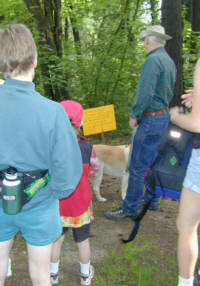 |
...get a job done.
|
How to...
 |
...get a job done.
|
| From
SW Trails
Portland, Oregon Don Baack
During the past two months, in Portland, Oregon we have conducted
an experiment to see if we could encourage walkers to carry buckets of
gravel to spread onto the trail on which they walked. SWTrails, a
volunteer citizen organization, proposed the idea to our local Portland
Parks Department, which agreed to help with the experiment. Parks
provided 6 cubic yards of gravel at each of 3 sites near the trail heads
of the trails which formed a three ray star in the park. The highest
points on the trail are about 350 feet above the lowest point. There
were 3800 feet of trails to be graveled. Two of the gravel stockpiles were
on the trail heads at the highest elevation. One site was at the
bottom of the trail system.
We began the process March 3rd with a volunteer work party using wheelbarrows
during which we graveled an estimated 500 lineal feet of trail. We
began graveling about 1000 to 1500 feet from the gravel sites, in other
words, we did some of the longest hauls first. It was very difficult
controlling the wheelbarrows on one trail due to the steep grade.
We then set up signs encouraging walkers to fill a bucket and help with the graveling of the trail. The idea was to load the bucket with as much gravel they thought they could carry, dump it on the trail where it was needed, and then carry the empty bucket to the next gravel site. (See the attached photos.) We obtained 30 two gallon buckets with plastic handles, and 6 five gallon buckets. We put 10 buckets at each gravel pile near the signs. We began by spray painting along the trail in the areas where we most needed gravel. But as the bucket brigade got underway, it became evident we could gravel the entire trail, so we changed the instructions to indicate that they should go to where there was no gravel on the trail. After one month, we had another volunteer work party and graveled an additional 500 feet of trail. By May 7th, two months after we began, the entire 3800 feet of trail was graveled. The two sites at the upper level had no gravel left. Only the lower pile had gravel remaining, approximately 2 cubic yards. During the life of the "bucket brigade" we lost 8 two gallon buckets and learned a few things about managing such an effort. 1. Be sure to provide a clean clear gravel dump site. We did not provide shovels. It is difficult to scrape gravel into a bucket, when weeds, sticks, cones and other debris interfere. 2. Assign a volunteer to watch over the buckets as the flow of traffic may not be balanced and the buckets will end up all at one place. Use small buckets. Even though one can load a 5 gallon bucket to the two gallon level, their size and awkwardness seems to intimidate most casual walkers. Mark the buckets if you are concerned that they may walk off or if it is difficult to get the small buckets. A few buckets were left along the trail from time to time, but no buckets were thrown into the park. Be sure to replace any lost buckets. Get rid of any buckets which are damaged. Some of the handles came off of our buckets so we discarded them. It seems to encourage "bucketeers" if the buckets are prefilled. 3. Do any structural work on the trail, water bars, side slope of the trail, other improvements before you begin graveling. We like to gravel during wet weather so the gravel is worked into the soil. Doing work on the trail before the graveling can make for a muddy mess, and if folks are not informed what you are about, you may get complaints. One lady with three off leash dogs complained about the mud, not realizing what we were doing. Of course her Mercedes got a little dirty from the muddy dog feet. Put up signs if you are doing improvements before you gravel. 4. Do a small sample of how you want the gravel spread so your "bucketeers" can see the model they are to emulate. 5. Toward of the end of the process, you may have to mark where you need additional gravel placed to complete the job to your standards. We marked on the little map of the trail where the gravel was needed so folks knew how far they would need to haul the gravel. The map had to be updated as the deposit location changed. 6. Be sure to keep the gravel stockpiles stocked. It really delays progress if one or more of your sites runs out of gravel. Once you start, keep things going as many people will chart the progress and really work to get it done, or so it appeared in our little project. 7. Before you begin, alert the media, as they seem to respond well to these types of self help efforts. They will want to see volunteers actually working, so you may have to stage a little of the work for the TV crew. 8. When you get done, invite all the volunteers and celebrate! This process worked very well in our Himes Park of SW Portland. Good luck in your application. Feel free to pass this on to anyone involved in trail work. |

Evelyn Porter and Don Baack at trail head

Carry the buckets down the trail
 |
